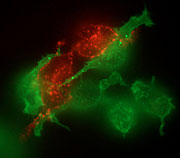- Number 358 |
- March 12, 2012
Modeling microbes to manage carbon dioxide

At Pacific Northwest National
Laboratory, studies of
difficult-to-cultivate
microorganisms and microbial
communities result in new
approaches to bioremediation
and renewable energy
development.
In the past decade, microbiologists began realizing that communities of microbes process energy and materials, which affects their environments. To understand how microbial communities function in a natural ecosystem, scientists at DOE’s Pacific Northwest National Laboratory have developed a novel kinetic model that represents microbial community dynamics in soil pores. With it, they can then evaluate the consequences of different strategies that microbes might use for degrading organic matter, such as cellulose in soil, and analyze how three-dimensional pore structure impacts biological activity.
“Modeling the dynamics of soil bacterial communities is extremely challenging because it involves disparate physical, chemical, and biological components,” said Dr. Allan Konopka, director of the Microbial Communities Initiative. “The unique feature of the new model is that it factors in a range of possible microsite conditions while accounting for heterogeneity in a three-dimensional system and treating the metabolism of microbial cells individually based on their own local environmental conditions and history.”
The scientists are interested in cellulose degradation because it’s the most abundant naturally occurring material on Earth and is a primary structural component of plants. The microbial breakdown of cellulose and related byproducts is a key process in the global carbon cycle. Each year, an estimated 100 billion tons of cellulose are synthesized by plants and subsequently degraded by microorganisms that, in turn, produce carbon dioxide via respiration.
The MCI is investigating processes at the microscale because these have macroscopic impacts on DOE’s carbon management mission. Scientists are studying microbial communities both in the natural environment and under better-controlled conditions in the lab. The lab studies represent the spatial heterogeneity found in soil aggregates, and simulation models can then incorporate the rules learned in the lab to predict behavior in the field.
This model was developed under PNNL’s Microbial Communities Initiative, which began in 2009 to advance the understanding of how microbial communities function in a natural ecosystem.[Kristin Manke, 509.372.6011,
kristin.manke@pnnl.gov]
